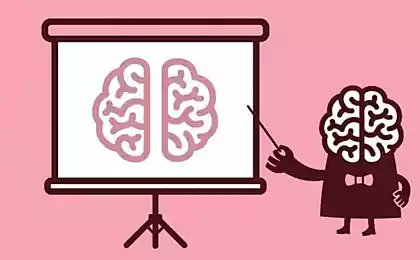981
from what the brain is buggy

In this article you will find five ordinary, everyday things, which, oddly enough, cause us to "think glitches»:
Doors
Have you ever happened to enter the room with a purpose (to take anything, for example), and then completely forget why you came? It turns out that the cause of these strange memory lapses ... lies at the door.
Psychologist at the University of Notre Dame (near Chicago) found that when passing through a doorway in the minds of the mechanism is triggered, conventionally called "boundary events" that separates one set of thoughts and memories from another, just like scenes in a movie.
Your brain automatically "send to archive" the thoughts that you have owned in the previous room, and clears space for new ones. "The borders of events" usually help organize our thoughts and memories, as we constantly move and switch to the new challenges.
But when we try to remember why they came ... they were going to do ... or find ... may be difficult.
Beeps
What annoys you more: alarm clock, beep the car stuck in a traffic jam or a reminder to your cell phone, that he ends up charging? None of these sounds are not caresses our hearing. These tones have become a kind of soundtrack of the modern world, but each of them continues to annoy us - because it is a small "brain glitch».
Evolution is not accustomed us to this kind of sound signals, so we try to realize. Natural sounds are created by energy transfer, often hitting one object to another, as in a drum battle. In this case, the energy is transferred into the drum and then gradually dissipated, and the sound gradually subside.
Our system uses a fading perception of sound information to understand what is happening - that sounds and why. A modern tones - it's like a machine that drove at a speed of 60 miles per hour, and instead slowly to brake suddenly hit the wall. The sound does not change, does not subside, and our brain can not understand what it is and where it came from.
Photos
With photos similar story. As a grandmother, who learned to use the Internet, but to him and was not used, we constantly take pictures, but subconsciously our brain is still not able to distinguish them from the objects or people, they are imprinted.
For example: Studies have shown that if a person offer to throw darts at a picture, the image on which he had nothing related to his accuracy will be much lower than if the same purpose it to provide a photo of Hitler or personal worst enemy.
In another experiment showed that if a person is asked to cut into small pieces photos related to childhood memories, he might be sweating.
Since we do not have a million behind years of practice, our brain is still not able to distinguish the appearance of reality.
Phones
You have it so: you feel that the phone vibrates, gets it, and with a puzzled look at the lifeless screen? If you, like most people, from time to time there are such "phantom vibrations", it is because your brain is doing wrong conclusions, trying to organize the chaos of your life.
Poor brain is constantly bombarded by all sorts of information. He has to filter the useless noise and isolate the important signals. In prehistoric times our ancestors constantly taking curves branches of snakes.
Today the brain misinterprets everything from clothing to rustle murmur in the stomach, and in a hurry to tell us what we call, or send SMS.
Similarly, illusions occur and vibrating phone.
Wheels
Noticed that sometimes the movie seems like the wheels of a vehicle rotate in the opposite direction? This is because the camera captures still images with a certain frequency, and the brain fills in the intervals between images, creating the illusion of continuous movement between similar frames. If the wheel does most of the turnover of between one and another frame, the most obvious to the direction of movement of the brain - the opposite, because it assumes the direction of the minimum difference between frames.
However, the effect of wheels rotating in the opposite direction may occur in real life. The main theory explaining this phenomenon is as follows: the brain perceives the movement about the same as the camera - in the form of a sequence of still images.
























